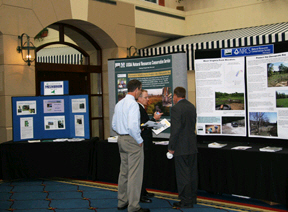|
| |
 Session Brings Together Stakeholders Focused on Improving the Bay Session Brings Together Stakeholders Focused on Improving the Bay
A panel of five representatives from the United States Department of
Agriculture Natural Resources Conservation Service (NRCS) collected insight and
suggestions from key stakeholders on improving water quality in the Chesapeake
Bay Watershed.
The listening session held July 14, 2008 in Annapolis, Maryland, brought together
over 250 representatives from Federal, State, and local government agencies,
academic professionals, non-government organization (NGO) representatives, and
landowners. The Chesapeake Bay Watershed spans Virginia, Maryland, Delaware, New
York, Pennsylvania, West Virginia, and Washington, DC, which feed the Chesapeake
Bay, the largest estuary in the United States.

Richard Coombe, NRCS Regional Assistant Chief East, provides an
opening address to the more than 200 people in attendance at the
July 14, 2008 Chesapeake Bay Listening Session. |
NRCS Regional Assistant Chief East Richard Coombe opened the session by
greeting local dignitaries, and thanking attendees for coming together to lend
their expertise in the effective appropriation of $188 million in conservation
funds for the Chesapeake Bay Watershed over the next four years. NRCS Chief Arlen
Lancaster who spoke about protecting, restoring, and enhancing the vital
wildlife habitats and river basins within the Watershed followed Coombe.
“We are here to get feedback from you, working on the ground and in the
field,” stated Lancaster. “We stand together to find common solutions to
implement effective conservation in this Watershed.”
The Food, Conservation, and Energy Act of 2008, also known as the 2008 Farm
Bill, approved $188 million in direct conservation funding to improve water
quality in the Chesapeake Bay Watershed. The input collected from this listening
session will have a beneficial impact on how and where the funding will be
allocated.

Those who attended the July 14, 2008 Chesapeake Bay Listening
Session in Annapolis, Maryland, took an opportunity to review the
Natural Resources Conservation Service displays and information
tables from the six States comprising the Chesapeake Bay Watershed. |
Over forty speakers took an opportunity to express their key concerns, and
priorities in working together to restore overall water quality in the
Chesapeake Bay Watershed. Topics ranged from expanding riparian buffers and
cover crops along streams and rivers to funding additional technical assistance
providers in the field and NRCS staff in district offices.
Local farmers and landowners play a critical role in ensuring that water
quality remains clean and safe on their land as it positively impacts the
success of livestock and agriculture produced.
“If we are going to be successful in improving water quality in the
Northeast, than we must make it the number one issue to focus on in the coming
years,” said Jim Michael, a West Virginia farmer.
Working together as a team, across all states and agencies, was the key
message from the listening session. Attendees recognized the importance of this
Watershed and that implementing effective conservation practices is critical to
ensuring long-term success.
< Back to NRCS New York News
| |
|

